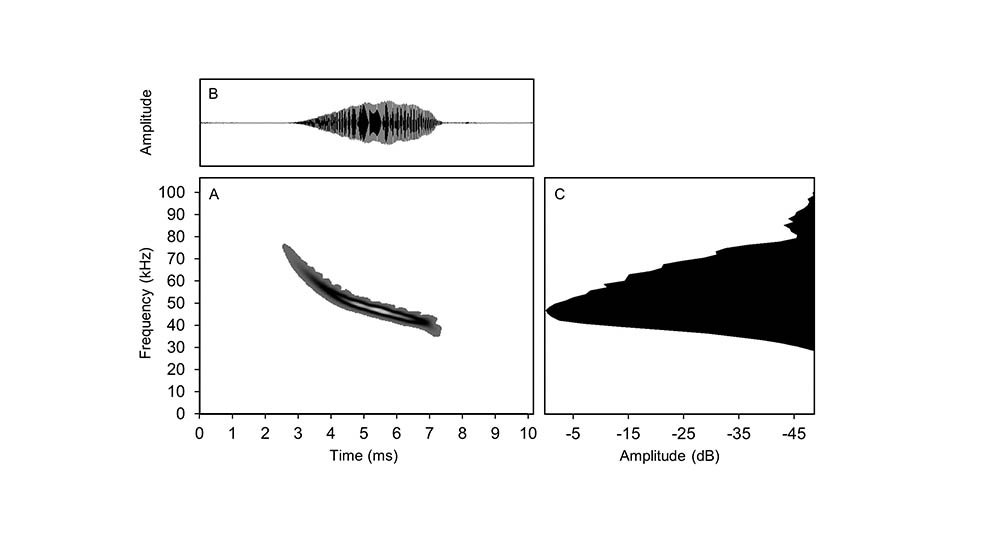Research Report: 2020
▼ Choose a report:

Powered by Research & Graduate Studies

Powered by Arts and Social Science

Powered by Fine Arts

Powered by Science and the Environment


A figure of a bat echolocation created by Darrian Washinger used in the online handbook.

Dr. Erin Fraser (Assistant Professor), with BEAS student Darrian Washinger
Projects undertaken by Dr. Erin Fraser of the School of Science and the Environment focused on studying bats by recording the echolocation calls of these cryptic animals.
Many bat species echolocate, which means that they produce high frequency calls and then use information from the echoes of those calls to navigate after dark and find prey. In doing so, bats can move easily and with high agility in complete darkness. Most humans can’t hear the echolocation calls of most bat species, but with specialized equipment ("bat detectors"), researchers can record the calls of wild bats. Analyses of these recordings can provide critical information about bat populations that are otherwise very difficult to study. It is possible to identify some bats to species based on characteristics of their echolocation calls and researchers can also use echolocation recordings to compare bat activity among locations or over time.
Globally, many bats are imperiled and facing population declines. Both of the resident species in Newfoundland are designated as endangered species! It is important now, more than ever, to learn more about the biology of these beautiful and important animals.
In 2020, Dr. Fraser engaged in two major projects involving echolocation recording techniques.
(1) Bats in Gros Morne National Park
Dr. Fraser collaborated with Dr. Tom Knight, an Ecosystem Scientist with Parks Canada based in Gros Morne National Park, as well as Ms. Darrian Washinger, to investigate the influence of forest disturbances on park bats. The research team was particularly interested in the potential influence of changes in forest structure resulting from hyperabundant moose on local bat activity. Ms. Washinger spent two summers using bat detectors to record the echolocation calls of bats in locations across Gros Morne National Park. She completed this work as part of her Masters degree in the Boreal Ecosystems and Agricultural Sciences Program at Grenfell Campus.
"We thought that moose meadows - patches of disturbed forest that have resulted from hyperabundant moose populations - would be less suitable habitat than other forest habitats for both bats and the insect prey that bats eat," explained Ms. Washinger. "Our measurements of local insects were lower in moose meadows than at the mature forest sites, but contrary to our predictions, these differences did not extend to local bat activity. Instead, we found that bat activity was most related to characteristics of the local vegetation. For example, the number of snags (dead tree) and the proportion of deciduous trees were both associated with higher levels of bat activity. While we did not see clear differences in bat activity in moose meadows as compared to other forest types, vegetation structure is clearly important to local bats. This may still indicate a potential effect of forest conversion by moose on summertime bat activity at the fine scale."
Previous echolocation recordings made by park biologists, as well as those made by Ms. Washinger, had an interesting and unexpected outcome. The recordings contained echolocation calls made by hoary bats, a species that had previously only been detected in Newfoundland a small number of times. During 2020, Ms. Washinger, Dr. Fraser, and their colleagues at Gros Morne National Park published a research paper describing the presence of hoary bats in the park.
"This species has only been found on and around insular Newfoundland a few times before, so this was an interesting contribution," said Dr. Fraser, adding that partnerships with Gros Morne National Park were crucial to the process.

Photo of a Hoary Bat
(2) In addition, in 2020 Dr. Fraser co-edited an online book that is a training resource for biologists wishing to learn about best practices in echolocation research.
"Acoustic recording is a very powerful tool for learning about bat populations, but the techniques are not user-friendly for novices," said Dr. Fraser. "There is a lot to know about selecting and deploying a bat detector, and the subsequent analyses of recordings also requires significant expertise. Many biologists may wish to engage in acoustic monitoring and research of bat populations, but lack the necessary skills, especially if bat monitoring is just one of many duties. Our goal was to create a resource that would be both appropriate for all skill levels and globally applicable," she said. More than 50 bat biologists from many international locations contributed written submissions, photos and recordings of echolocation calls to the project.

A bat locator in situ.
"We have contributions from around the world, including India, Vietnam, Australia, Namibia, and many parts of North America and Europe," said Dr. Fraser. The work was funded by a Public Engagement Accelerator Grant and was done in partnership with Bat Conservation International, a conservation organization based in the US.